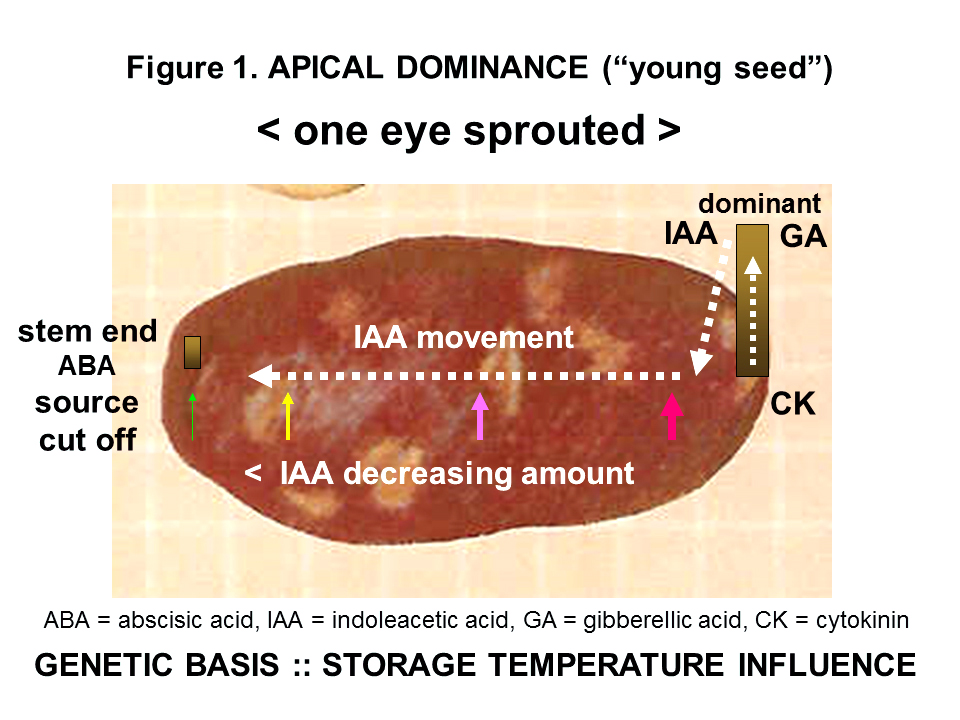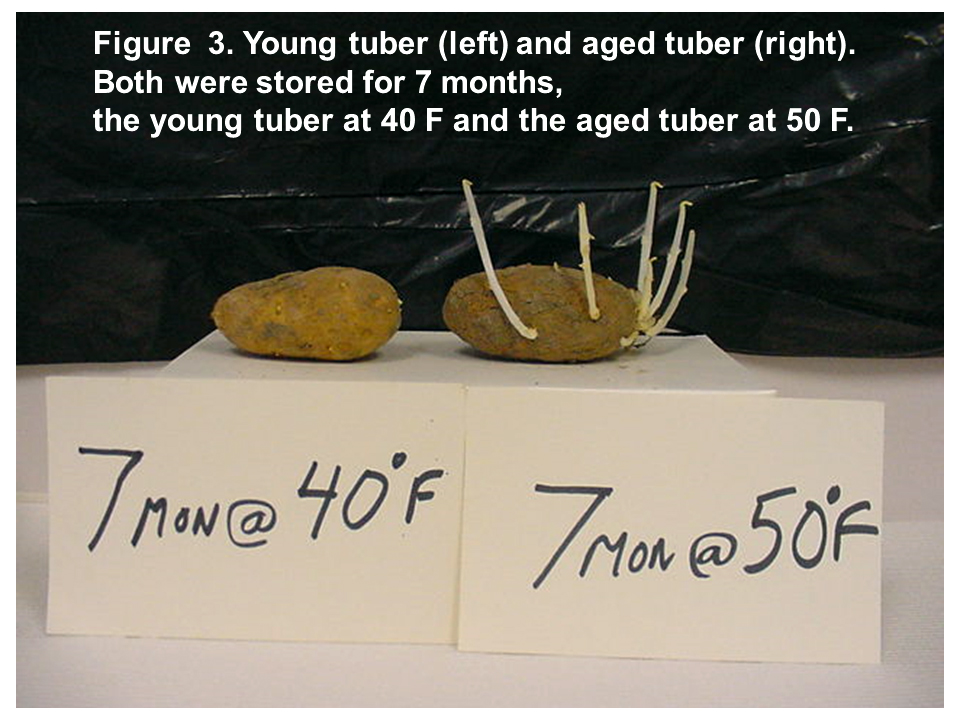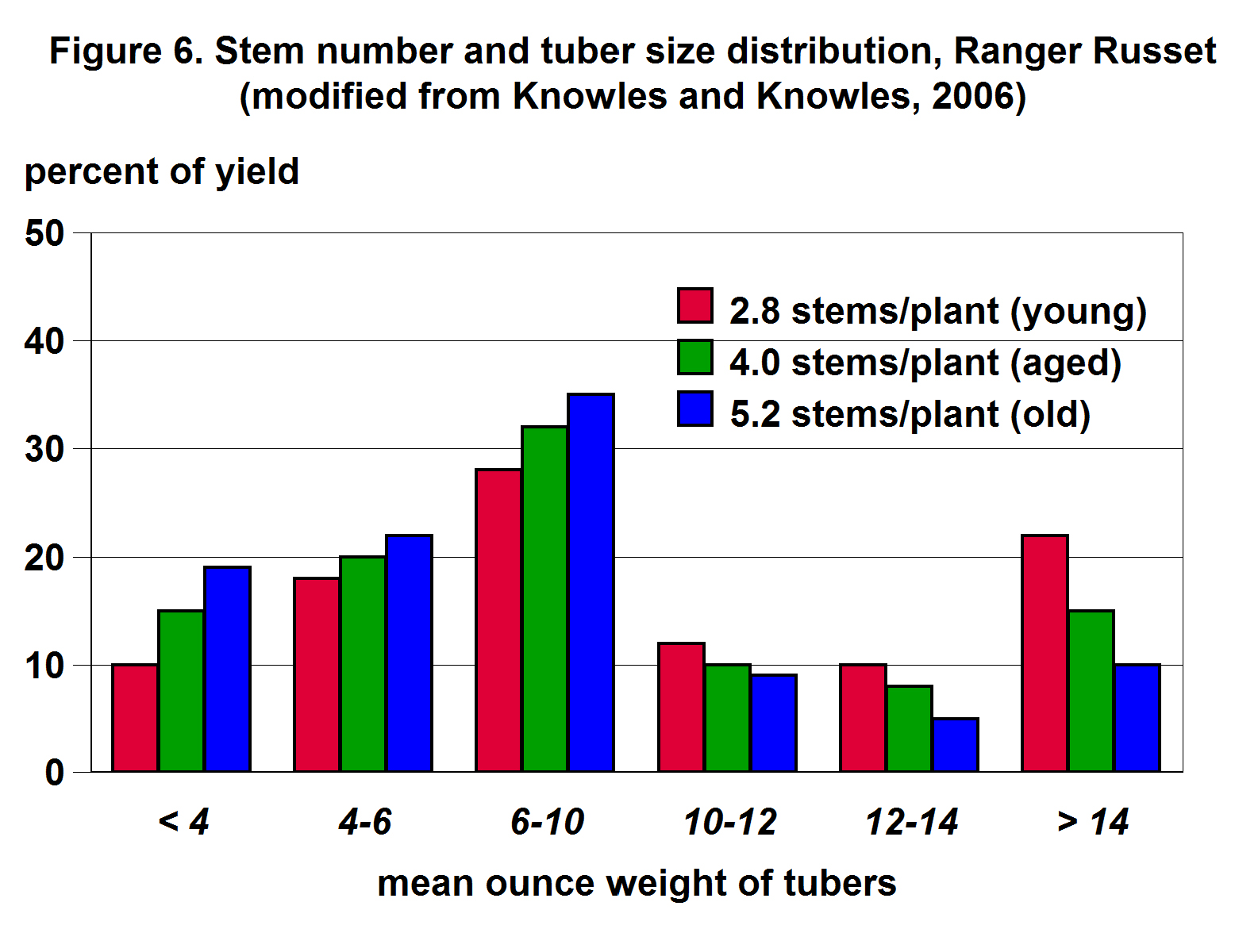

Alexander D. Pavlista, Crop Physiologist
When potato seed-piece tubers emerge, some have multiple sprouts per tuber while others have only one or two sprouts. What could cause this difference? This publication discusses the basic physiology of tubers, their aging, the results of aging, and appropriate markets for the harvested tubers.
Tuber aging is important to a grower as it affects seed performance, plant growth, and harvested tuber size and number. Indirect effects of aging on processing (frying) tubers are changes in sugar content, specific gravity, and sprout control in storage. Aging is not solely time-dependent but also a result of genetics and stress.
Biologists have realized for over a century that organisms, plants, and animals age internally at different rates that cannot be explained by time alone. Physiological aging is affected by two factors, genetic predisposition and environmental stress. Since potatoes are grown from cloned stem tissue (tubers), genetic predisposition is at the level of cultivars. Environmental stresses in the field are primarily moisture, temperature, nutrients, pest injury, and mechanical damage. In storage, stresses are temperature, moisture, aeration, bruising, and disease.

Physiological aging in potato plants consists of vine aging during the growing season and tuber aging during the storage season. Vine aging is calculated with a formula based on daily air temperature fluctuations. Tuber aging concerns the viability of tubers used for seed. This is broadly defined as “. . . physiological status of the tuber as it affects productivity” (Bohl et al., 2003). Although tuber aging can occur during the growing season due to stress, it is poorly understood. Plants that die prematurely often have aged tubers. Late-season high soil temperature can play a major role and may stimulate premature sprouting in the field. However, the main cause of seed tuber aging is the temperature during storage. Higher storage temperatures are associated with greater aging but the exact relationship is not yet established. A correlation does exist; however, there is no true predictor of aging at this time.
There are five stages of physiological aging in tubers and these are based on sprouting. Since tuber aging cannot be measured directly, a bioassay is used to estimate the age of a tuber seed lot based on a randomly selected sample. The tuber sample is placed in darkness at room temperature for a few weeks and observed, then matched to the established stages of tuber aging. This is the only reliable determination of tuber aging.

Before describing the physiological basis underlying the stages of tuber aging, it is necessary to understand the physiology of the harvested tuber. Dormancy is sometimes considered a pre-aging stage. Toward the end of the growing season, abscisic acid (ABA), an inhibitor, is produced by the vine and transported into the tubers. This genetically controlled hormone is responsible for tuber dormancy. Dormancy is characterized by a period during which sprouting will not occur even under optimal conditions. Dormancy is broken when the amount of abscisic acid in the tuber eyes decreases through metabolic breakdown to a level that allows the eyes to respond to conditions favoring sprouting. In physiological aging models, tuber aging does not commence until dormancy is broken. Breaking tuber dormancy also entails the production of a growth hormone, gibberellic acid (GA), in the tuber. Sometimes, growers apply GA to dormant tubers to induce sprouting.

Young seed is characterized by one dominant eye that suppresses the sprouting of the other eyes. The suppressing eye is at the apical end of the tuber or “bud” end, which is the furthest eye from where the tuber was attached to the vine (Figure 1). This physiological phenomenon is termed “apical dominance” and is common in the plant kingdom, e.g., suppression of growth of lower buds by the apex of the plant. It is mediated primarily by the hormone indole-acetic-acid (IAA), an auxin. In the case of potato tubers, the eye and young sprout produce IAA, which travels down the tuber and suppresses sprouting of the other eyes. This suppression is dependent on IAA concentration, just as dormancy is dependent on ABA concentration.
Also produced at the apex and traveling down the sprout is GA, which promotes sprout elongation and counteracts dormancy. From the base of the eye, young root cells produce cytokinin (CK), which promotes cell division and moves up the sprout. This hormone counteracts the actions of IAA. The result is that physiologically young tubers produce one or two main stems or a low stem number per acre. There is initially one sprout at the apical end, and later a second sprout may appear from the eye farthest from the dominant eye. This is because the IAA level is lower. It is important to note that the genetic makeup of a cultivar is the basis of how much ABA and IAA are produced, how sensitive tissues are to them, how fast the hormones are broken down, and how much and when counteracting hormones are produced. Environment influences all of these but the basis is genetics.
Older seed tubers (aged seed) are characterized by the loss of apical dominance among eyes, i.e., effective IAA levels in tubers are decreased sufficiently to allow other eyes to sprout (Figure 2). This develops gradually over time but the time can be shortened by heat (Figure 3), or the dominance can be disrupted by cutting the tuber, thereby breaking the translocation path of IAA through the tuber. Removal of the apical sprout will also disrupt apical dormancy, although in young tubers, it may be reinstated by the next eye closest to the apical end. This stage is observed by the appearance of several eyes sprouting and results in several main stems per plant.
As tubers continue to age, apical dominance within the sprout breaks down; that is, the dominance effect of the tip of the sprout where IAA is produced on branch buds below has ended. The result is that sprouts of physiologically old seed tubers are branched (Figure 4). There may be a proliferation of small stolons and a large tuber set of small tubers.

The IAA mechanism is now so broken down that not only do sprouts proliferate their branches into underground stolons, these do not grow much and will form tiny tubers quickly. Some cultivars like ‘Russet Norkotah’ are prone to this.
Since the bioassay takes at least a few weeks, it presents a kind of “delayed exposure snapshot” of aging. For an immediate estimate on the relative physiological age of seed lots, a heat accumulation calculation is commonly used. Since duration of temperature exposure is the key driving force for aging tubers, an equation or model has been used as an alternative to the bioassay. However, this is an indirect estimate of aging and may give inaccurate results or conclusions. The heat accumulation model is best for comparing seed lots for their relative degree of aging. The equation is
tuber physiological age =
(average daily storage temperature minus the base temperature of 39 oF)
times the number of days from dormancy to planting.
The major weakness of this model is that it does not take into account chronological aging, i.e., no aging at the base temperature at which aging does occur. Therefore, this model underestimates the actual physiological age of tubers and the longer the tubers are in storage, the greater the inaccuracy.
Plants growing from seed tubers of different physiological ages perform differently as outlined in Table I. For example, in Australia, Grice (unpublished) compared plants grown from young Kennebec seed (tuber physiological age = 0) to plants from aged seed (physiological age = 2100). Plants from aged seed emerged earlier, grew faster, and had higher early yields, but yielded less later than young seed (Figure 5). Another key effect of tuber aging is the number of stems per plant and the effect of stem number on yield distribution of varying tuber sizes. Old seed produced more stems (5.2/plant) formed from tubers, and more tubers were between 6 and 10 ounces, but young seed had fewer stems (2.8/plant) and more tubers over 14 ounces (Figure 6). Aged seed (4.0 stem/plant) was intermediate.
Since the major factor in storage that accelerates tubers through the stages of aging is temperature, aging can be manipulated to produce a desired tuber age at planting. Planting older seed of cultivars that tend to oversize such as ‘Yukon Gold’ may have advantages. It may improve uniformity and increase the number of marketable-sized tubers, especially for early markets. This may also be true for seed production in which a smaller tuber size profile might be preferred. Some cultivars such as ‘Russet Norkotah’ do not benefit from aging while others such as ‘Yukon Gold’ and ‘Shepody’ might, due to their tendency to oversize for their markets. Note that cultivars differ in the extent of their responses to aging.
To age seed, store it at 38 oF, then before planting store for two to six weeks at 55–60 oF. To hold young seed, store at 38 oF and warm to 45 oF just before cutting. Plant in soil that has about the same temperature as the tubers. Cutting tubers breaks apical dominance between eyes, thus releasing eyes to sprout. Because of this, sprout removal may result in more stems and smaller tubers.
Because young seed emerges slower, there is a greater chance of seed decay and cankers (stem and stolon). Do not plant seed right out of cold storage into soil as this will promote condensation of moisture on the seed and promote decay. Planting young seed in warmer soil can hasten its sprout emergence and growth. Warm seed to 50–60 oF for a few days and plant in soil slightly cooler. This will add some physiological age to the seed tuber or pieces. Seed planted in light sandy soil that warms rapidly tends to produce more stems and set more tubers. The result is smaller harvested tubers. Extra nitrogen starter fertilizer can partially overcome the effects associated with aging; that is, N can partially mimic young seed characteristics. Note that later planting also tends to produce more stems per plant and lower yield.


Sprouting of tubers under light produces short, tough, green sprouts. Green sprouting or chitting enhances emergence, tuber formation, vine size, and earlier maturation by as much as two weeks. It is used for early harvested yields. The light requirement is low and stacking trays are often used. Chitted tubers are planted with cups, not picks, to avoid sprout damage.
When a longer growing season is possible and large tubers are marketable such as bakers and French fryers, young seed ready to sprout may be desired. On the other hand, for an early fresh market, older seed at the multiple sprout stage may be more desirable to get a higher yield early and a quicker vine senescence. Older seed might be more desirable for seed production where a smaller tuber profile at harvest may be more desired than bulk yield. To decide the optimal physiological age to plant, the cultivar’s characteristics, the market for the crop and the anticipated conditions during the growing season must be considered.
Table I. Performance Characteristics Associated with Physiological Age of Seed Tubers.
| Characteristic | Young Seed | Old Seed |
|---|---|---|
|
Emergence |
SLOWER |
FASTER |
|
Stand |
GREATER |
LESSER |
|
Early Vigor |
GREATER |
LESSER |
|
Foliage |
MORE |
LESS |
|
Stem Number |
LESS |
MORE |
|
Tuber Formation |
LATER |
EARLIER |
|
Formation Period |
LONGER |
MORE UNIFORM |
|
Tuber Number |
LESS |
MORE |
|
Tuber Bulking |
LONGER |
SHORTER |
|
Tuber Sizing |
LARGER |
SMALLER |
|
Vine Senescence |
LATER |
SOONER |
|
Early Harvest Yield |
LOWER |
GREATER |
|
Later Harvest Yield |
GREATER |
LOWER |
Extension is a Division of the Institute of Agriculture and Natural Resources at the University of Nebraska—Lincoln cooperating with the Counties and the United States Department of Agriculture.
University of Nebraska—Lincoln Extension educational programs abide with the nondiscrimination policies of the University of Nebraska—Lincoln and the United States Department of Agriculture.
© 2016, The Board of Regents of the University of Nebraska on behalf of the University of Nebraska—Lincoln Extension. All rights reserved.